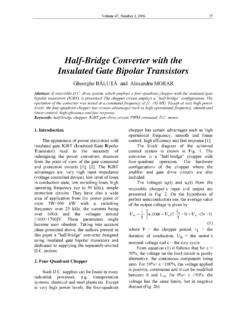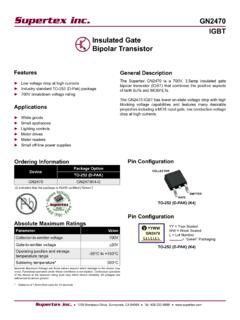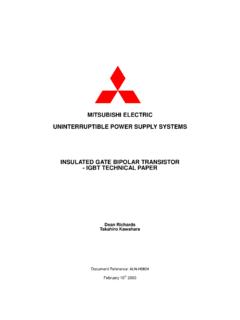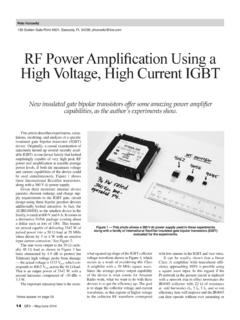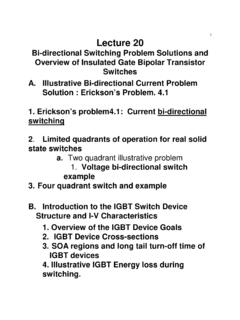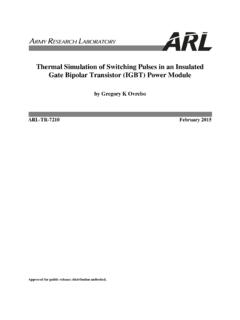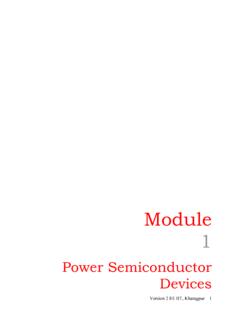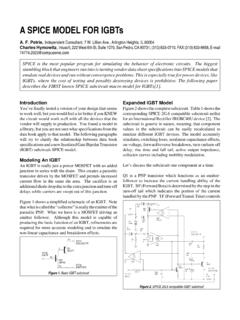Transcription of Failure Precursors for Insulated Gate Bipolar Transistors ...
1 Failure Precursors for Insulated gate Bipolar Transistors (IGBTs) Nishad Patil1, Diganta Das1, Kai Goebel2 and Michael Pecht1 1 Center for Advanced Life Cycle Engineering (CALCE) University of Maryland College Park, MD 20742, USA 2 NASA Ames Research Center Moffett Field, CA 94035, USA Abstract Failure Precursors indicate changes in a measured variable that can be associated with impending Failure . By identifying Precursors to Failure and by monitoring them, system failures can be predicted and actions can be taken to mitigate their effects. In this study, three potential Failure precursor candidates, threshold voltage, transconductance, and collector-emitter ON voltage, are evaluated for Insulated gate Bipolar Transistors (IGBTs).
2 Based on the Failure causes determined by the Failure modes, mechanisms and effects analysis (FMMEA), IGBTs are aged using electrical-thermal stresses. The three Failure precursor candidates of aged IGBTs are compared with new IGBTs under a temperature range of 25-200oC. The trends in the three electrical parameters with changes in temperature are correlated to device degradation. A methodology is presented for validating these Precursors for IGBT prognostics using a hybrid approach. Keywords: Failure Precursors , IGBTs, prognostics Failure Precursors indicate changes in a measured variable that can be associated with impending Failure [1]. A systematic method for Failure precursor selection is through the use of the Failure modes, mechanisms, and effects analysis (FMMEA) [2].
3 By identifying and monitoring the Precursors , the extent of deviation or degradation from expected normal operating conditions can be assessed to provide advanced warning of failures. In this article, three electrical parameters of the Insulated gate Bipolar Transistors (IGBTs), threshold voltage, transconductance, and collector-emitter ON voltage, are evaluated for IGBTs aged by electrical-thermal stresses. The aged IGBT parts are compared with new parts in a temperature range of 25-200oC to assess their potential as precursor candidates. INTRODUCTION Insulated gate Bipolar Transistors (IGBTs) are used in switching applications for automobile and train traction motors, in high voltage power supplies, and in aerospace applications such as switch mode power supplies (SMPS) to regulate DC voltage.
4 The Failure of these switches can reduce the efficiency of the system or lead to system Failure . IGBTs have switching characteristics similar to a metal oxide semiconductor field effect transistor (MOSFET), as well as high current and voltage capabilities of a Bipolar junction transistor (BJT). The structure of an IGBT is similar to that of a vertical diffusion power MOSFET (VDMOS) [3] except for an additional p+ layer above the collector as seen in Figure 1. The main characteristic of the vertical configuration is that the collector (drain) forms the bottom of the device while the emitter (source) region remains the same as a traditional MOSFET in this configuration.
5 Figure 1 represents the schematic structure of the device used in this study. The majority carriers in this device are electrons. The additional p+ layer in the IGBT acts as a source of holes that are injected into the body (n- region) during operation. Figure 1: Schematic of IGBT Operation Applying a positive voltage to the gate switches on the device when an inversion layer ( , a conductive channel) is created in the p- region just below the gate oxide, allowing for electron flow. Electrons flow from the emitter through the conductive channel to the collector terminal. As IGBTs are switched on by voltage rather than current, they have faster switching speeds in comparison to the BJT.
6 A positive voltage applied to the collector with the emitter at ground causes injection of positive carriers from the p+ layer, which contacts the collector, into the body. This leads to excess charges in the body of the device reducing body resistance. The process of reducing body resistance with increasing carrier concentration is called conductivity modulation. This process allows the IGBT to have a lower on-resistance compared to the power MOSFET. The punch-through IGBT used in this study has an additional n+ layer, called the buffer layer, above the p+ layer that contacts the collector terminal. When the IGBT is turned off, the positive carriers injected from the p+ layer remain in the body of the device.
7 The additional n+ layer in the punch-through configuration allows for faster evacuation of the stored positive carriers in the body. This reduces the current fall time, turn-off time and switching loss of the IGBT. Failure MODES MECHANISMS AND EFFECTS ANALYSIS (FMMEA) OF IGBTs FMMEA is a methodology to identify potential Failure mechanisms and models for all potential Failure modes, and to prioritize Failure mechanisms. The output of the FMMEA process is a list of critical Failure mechanisms that help us identify the Precursors to monitor and the relevant physics of Failure models to use; enabling the prediction of the component s remaining useful life.
8 In the hybrid prognostic methodology being used in this research (described in the hybrid PHM methodology section); FMMEA is the first step in the analysis. The Failure modes for the IGBT are in the form of degradation of certain key electrical parameters ( , leakage current, threshold voltage) or the loss of functionality (inability to turn-off). The Failure causes can be due to environmental conditions or operating conditions. For example, failures could be caused by high humidity, leading to corrosion of electrical contacts. Failures could also be caused by large temperature variations leading to unequal expansion within different materials that make up the device resulting in interface degradation.
9 High temperatures during operation could lead to an accumulation of defects in the gate oxide leading to its breakdown by the time dependent dielectric breakdown mechanism. The FMMEA performed in this study is limited to die level failures only. Critical transistor Failure mechanisms include hot electrons and gate oxide breakdown. gate oxide breakdown can result in excessive leakage current, increased standby power, and an increase in transistor response time. The FMMEA for IGBTs is illustrated in Figure 2. In this figure, one critical Failure mechanism for each site is listed. Potential Failure SitesOxidePotential Failure ModesShort circuit, loss of gate control, increased leakage currentPotential Failure CausesHigh temperature, high electric field, overvoltagePotential Failure MechanismsTime dependent dielectric breakdown (TDDB)
10 Oxide, oxide/substrate interfaceDevice bodyHigh leakage currentsLoss of gate control, device burn-outOvervoltage, high current densitiesHigh electric field, overvoltage, ionizing radiationHot electronsLatch-upPotential Failure SitesOxidePotential Failure ModesShort circuit, loss of gate control, increased leakage currentPotential Failure CausesHigh temperature, high electric field, overvoltagePotential Failure MechanismsTime dependent dielectric breakdown (TDDB)Oxide, oxide/substrate interfaceDevice bodyHigh leakage currentsLoss of gate control, device burn-outOvervoltage, high current densitiesHigh electric field, overvoltage, ionizing radiationHot electronsLatch-up Figure 2: FMMEA of IGBTs The potential Failure causes for all the mechanisms as shown in Figure 2 involve high electric fields.


